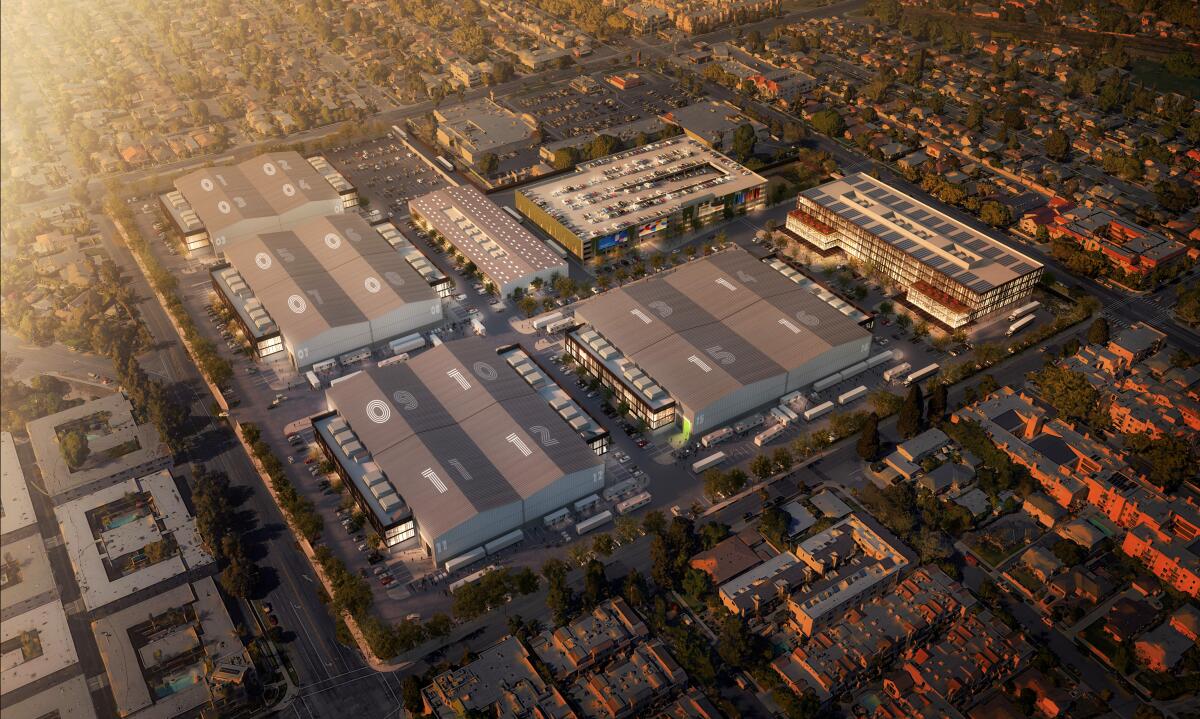Hollywood backlots remained nearly full during the pandemic. Here’s why

- Share via
Hollywood’s soundstages remained nearly fully occupied throughout the first year of the COVID-19 pandemic even as filming halted, highlighting the scarcity of studio space in the region, according to a new report.
The average annual soundstage occupancy rate reached 94% in 2020, up from 93% in 2019, according to the new report from Film LA, the nonprofit group that handles film permits for the city and county.
One explanation: Many studios reported full backlots as producers sought out more controlled environments for outdoor shooting. Even with a 87-day shutdown, the number of shoot days on backlots dropped only 15 % from 2019 to 2020.
Greater Los Angeles has enjoyed a boom in local film and TV production, but the surge in demand has created a crunch for studio space.
The report comes as California is attempting to spur more investment in soundstages across the region. Last summer, state legislators authorized an additional $150 million in tax credits for filming on renovated or newly constructed soundstages as part of a plan to lure more production to the state.
The scarcity of studio space has led to rents rising 15% in the last five years and caused some producers to leave the region. Most studio operators did not lose a single lessee during the production shutdown, according to the report.
“There was still a great degree of faith that the industry was going to return and they were not willing to make rash or snap judgments about their need for a soundstage,” FilmLA spokesman Philip Sokoloski said. “They chose to hold on to it, believing that there would be a return to production in the near future. It highlights the resiliency of the Los Angeles area market.”
Television production, spurred by the intensifying competition between new streaming platforms, drove demand for both on location and stage-based production. TV shows accounted for 72% of all stage and backlot-based shoot days, up from 62% in 2019.
The report also highlights how feature films struggled to resume production during the first year of the pandemic, registering just 146 shoot days in 2020, down 50% from 2019.
“We just don’t have the space for them anymore because we have this explosion of streaming content that’s been occupying stages,” said Anne Hurts, FilmLA senior research analyst, said. “A lot of independent filmmakers have indicated to me that it was just too risky for them to shoot during COVID, and even now, because they don’t know if things are going to get shut down again.”
Internet creators also were able to take advantage of stage use during the pandemic, generating 141 shoot days, up 93% from 2019.
Other states like New Mexico have had success luring companies like Netflix and NBCUniversal by tying tax credits to infrastructure investment. Before the pandemic, FilmLA cited the lack of studio space in L.A. County as one reason for a surprising 6% drop in location filming at the end of 2019.
Help is on the way. There are at least 14 new studios or studio expansions underway in greater Los Angeles, according to the report. These include an expansion at the Universal Studios lot and $1.25 billion revamp of LA’s CBS Television City to help bring it into the streaming era, as well as the plan to build new stages at Warner Bros. Ranch.
The historic ranch in Burbank, where shows like HBO’s “Perry Mason” are filmed, will get 16 new stages as part of a $500 million plan, the reported noted.
L.A. already leads world in the amount of soundstage space with 5.4 million square feet. The UK is a close second with 4.7 million square feet, according to the report. New York and Georgia have 2.4 and 2 million square feet of stage space, respectively.
Inside the business of entertainment
The Wide Shot brings you news, analysis and insights on everything from streaming wars to production — and what it all means for the future.
You may occasionally receive promotional content from the Los Angeles Times.
More to Read
Inside the business of entertainment
The Wide Shot brings you news, analysis and insights on everything from streaming wars to production — and what it all means for the future.
You may occasionally receive promotional content from the Los Angeles Times.











